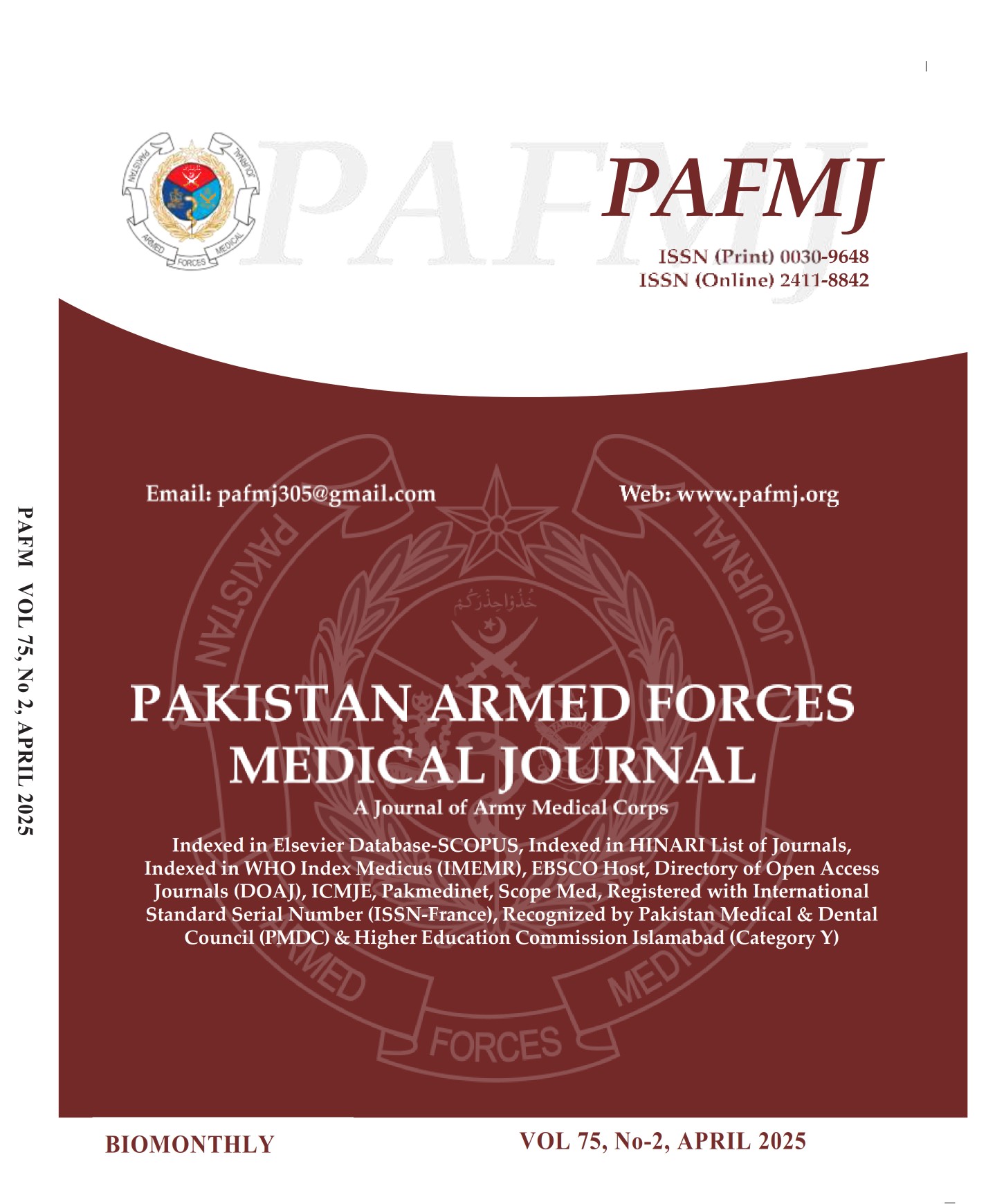Frequency of Burst Abdomen and Associated Risk Factors After Emergency Laparotomy in A Tertiary Care Hospital from Rawalpindi
DOI:
https://doi.org/10.51253/pafmj.v75i2.11868Keywords:
Emergency Laparotomy, Risk Factors, Surgical Wound DehiscenceAbstract
Objective: To assess the frequency of burst abdomen and associated risk factors after in patients undergoing laparotomy.
Study Design: Prospective longitudinal study
Place and Duration of Study: Combined Military Hospital Rawalpindi, Pakistan from Jan to Jun 2023
Methodology: One hundred and sixteen patients meeting our inclusion criteria who underwent emergency laparotomy were included in the study. Convenience sampling was performed for patient selection. The primary outcome was development of burst abdomen.
Results: Of 116 patients, 75(64.7%) were male and 41(35.5%) were female, with a mean age of 41.11±15.13 years. The major primary diagnosis for which patients underwent laparotomy were peritonitis, intestinal obstruction and blunt trauma. Only 12(10.34%) patients developed burst abdomen. The major risk factors associated with burst abdomen (p< 0.05) were age, history of smoking, anemia, obesity, diabetes mellitus, malnutrition, post-operative ileus, wound infection, wound leakage, post-operative cough and vomiting. Obesity, smoking and vomiting were not significantly associated with development of burst abdomen (p> 0.05).
Conclusion: We found that abdominal wound dehiscence, or burst abdomen, occurred in 10.34% patients who underwent emergency laparotomy at our set-up. The associated risk factors included wound infections, anastomotic leaks, and the presence of coexisting conditions like peritonitis, diabetes, anemia, malnutrition and advanced age.
Downloads
References
Swaroop M, Williams M, Greene WR, Sava J, Park K, Wang D. Multiple laparotomies are a predictor of fascial dehiscence in the setting of severe trauma. Am Surg 2005;71(5):402-405.
https://doi.org/10.1177/000313480507100507
Bartlett DC, Kingsnorth AN. Abdominal wound dehiscence and incisional hernia. Surgery 2006;24(7):234-238.
https://doi.org/10.1383/surg.2006.24.7.234
George II, Janis JE, Attinger CE. Wound healing: an overview. Plast Reconst Surg 2006;117(7S):1e-S.
https://doi.org/10.1097/01.prs.0000222562.60260.f9
Kvist M, Burcharth J, Nielsen YW, Jensen TK. Abdominal subcutaneous obesity and the risk of burst abdomen: a matched case–control study. Langenbecks Arch Surg 2022;407(8):3719-3726.
https://doi.org/10.1007/s00423-022-02682-7
Alam MS. Study of burst abdomen: It’s causes and management. Int J Life Sci 2024;13(5):23-33.
https://doi.org/10.21275/mr23110175136
Mehdorn M, Groos L, Kassahun W, Jansen-Winkeln B, Gockel I, Moulla Y. Interrupted sutures prevent recurrent abdominal fascial dehiscence: a comparative retrospective single center cohort analysis of risk factors of burst abdomen and its recurrence as well as surgical repair techniques. BMC Surg 2021;21:1.
https://doi.org/10.1186/s12893-021-01219-x
Hegazy TO, Soliman SS. Abdominal wall dehiscence in emergency midline laparotomy: incidence and risk factors. Egypt J Surg 2020;39(2).
https://doi.org/10.4103/ejs.ejs_7_20
Wong SY, Kingsnorth AN. Abdominal wound dehiscence and incisional hernia. Surgery 2002;20(5):100-103.
https://doi.org/10.1383/surg.20.5.100.14624
Dietz UA, Debus ES, Thiede A, Kuhfuss I. Inverting bilateral figure-of-eight suture of the rectus sheath after burst abdomen with destruction of the linea alba: a new technique. J Plast Reconst Aesthet Surg 2007;60(4):389-392.
https://doi.org/10.1016/j.bjps.2005.11.044
Menke NB, Ward KR, Witten TM, Bonchev DG, Diegelmann RF. Impaired wound healing. Clin Dermatol 2007;25(1):19-25. https://doi.org/10.1016/j.clindermatol.2006.12.005
Israr S, Khan MK, Farid A, Qaiser N, Akhtar K, Jalal A. Frequency of Abdominal Wound Dehiscence/Burst Abdomen in Patients of Laparotomy. Pak J Med Health Sci 2022;16(09):772. https://doi.org/10.53350/pjmhs22169772
Waqar SH, Malik ZI, Razzaq A, Abdullah MT, Shaima A, Zahid MA. Frequency and risk factors for wound dehiscence/burst abdomen in midline laparotomies. J Ayub Med Coll Abbottabad 2005;17(4).
Ogbuanya AU, Ugwu NB. Emergency laparotomy at district hospitals in a developing nation: a review of indications and outcomes of treatment. J Emerg Pract Trauma 2021;7(2):111-117. https://doi.org/10.34172/jept.2021.06
Kenig J, Richter P, Lasek A, Zbierska K, Zurawska S. The efficacy of risk scores for predicting abdominal wound dehiscence: a case-controlled validation study. BMC Surg 2014;14:1-6. https://doi.org/10.1186/1471-2482-14-65
Sandy-Hodgetts K, Norman R, Edmondston S, Haywood Z, Davies L, Hulsdunk K, et al. A non-randomised pragmatic trial for the early detection and prevention of surgical wound complications using an advanced hydropolymer wound dressing and smartphone technology: The EDISON trial protocol. Int Wound J 2022;19(8):2174-2182.
https://doi.org/10.1111/iwj.13823
Lotfy WE, Ali RM, Ashour HR, Elhady MO, Raafat A, Fattah A. Risk Scoring for Burst Abdomen Prediction in Patients with Midline Laparotomy. Eur J Molec Clin Med 2021;8(4):984-991.
Ibrahim A, Ibrahim S, Abd El-Fattah A. Management of Burst Abdomen and Abdominal Wall Reconstruction. Al-Azhar Med J 2022; 51(4): 2029-2038.
https://doi.org/10.21608/amj.2022.258327
Denys A, Monbailliu T, Allaeys M, Berrevoet F, van Ramshorst GH. Management of abdominal wound dehiscence: update of the literature and meta-analysis. Hernia 2021;25(1):449-462. https://doi.org/10.1007/s10029-020-02294-4
Dowsett C. Prevention, identification, and management of surgical wound dehiscence: Early intervention and treatment. Wounds 2024;20(4):21.
Downloads
Published
Issue
Section
License
Copyright (c) 2025 Muhammad Sheraz Abbasi, Imran Ashraf, Asad Noor, Sajid Zaman, Abaidullah Shaukat, Bilal Sikandar Nagra

This work is licensed under a Creative Commons Attribution-NonCommercial 4.0 International License.















